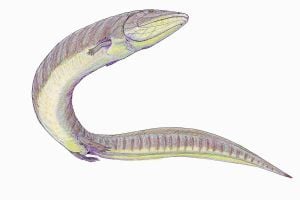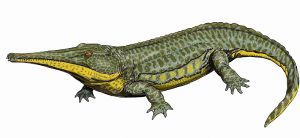Difference between revisions of "Labyrinthodontia" - New World Encyclopedia
Rick Swarts (talk | contribs) (added article from Wikipedia and credit/category tags) |
Rick Swarts (talk | contribs) |
||
| Line 1: | Line 1: | ||
{{Claimed}}{{Contracted}} | {{Claimed}}{{Contracted}} | ||
| − | [[Image:Pteroplax_DB.jpg|thumb|''Pteroplax''.]]''' | + | [[Image:Pteroplax_DB.jpg|thumb|''Pteroplax''.]] |
| + | |||
| + | '''Labyrinthodontia''' is an [[extinction|extinct]], traditional group (superorder or subclass) of [[amphibian]]s that constituted some of the dominant animals of Late [[Paleozoic]] and Early [[Mesozoic]] times (about 350 to 210 million years ago). They are considered to include the first vertebrates known to live on solid ground, and to have been ancestral to at least some of the groups of modern amphibians and a bridge to the reptiles (NSMC 2002). Labryinthodonts persisted from the Late Devonian of the Paleozoic to the Late Triassic of the Mesozoic, and flourished in the Carboniferous period (NSMC 2002). | ||
| + | |||
| + | The name Labryinthodonita , which is from the [[Greek language|Greek]] for "maze-toothed," describes the pattern of infolding of the [[dentine]] and [[Tooth enamel|enamel]] of the teeth, which are often the only part of the creatures that [[fossilize]]. They are also distinguished by a heavy solid skull, and complex vertebrae, the structure of which is useful in older classifications of the group. | ||
| + | |||
| + | {{Paleozoic Footer}} | ||
| + | {{Mesozoic Footer}} | ||
| + | |||
==Anatomy== | ==Anatomy== | ||
| + | |||
| + | |||
| + | |||
| + | |||
Labyrinthodonts are named for the pattern of [[infolding]] of the [[dentine]] and [[Tooth enamel|enamel]] of the teeth, that resembles a [[maze]] (or [[labyrinth]]). Labyrinthodonts could be up to four meters long. They were short-legged and large headed. Their skulls were deep and massive, and their jaws were lined with small, sharp, [[conical]] teeth. Also, there was a second row of teeth on the roof of the mouth. In their way of living labyrinthodonts were probably similar to fishes - they laid eggs in the water, where their [[larvae]] developed into mature animals. | Labyrinthodonts are named for the pattern of [[infolding]] of the [[dentine]] and [[Tooth enamel|enamel]] of the teeth, that resembles a [[maze]] (or [[labyrinth]]). Labyrinthodonts could be up to four meters long. They were short-legged and large headed. Their skulls were deep and massive, and their jaws were lined with small, sharp, [[conical]] teeth. Also, there was a second row of teeth on the roof of the mouth. In their way of living labyrinthodonts were probably similar to fishes - they laid eggs in the water, where their [[larvae]] developed into mature animals. | ||
Revision as of 22:22, 30 October 2007
Labyrinthodontia is an extinct, traditional group (superorder or subclass) of amphibians that constituted some of the dominant animals of Late Paleozoic and Early Mesozoic times (about 350 to 210 million years ago). They are considered to include the first vertebrates known to live on solid ground, and to have been ancestral to at least some of the groups of modern amphibians and a bridge to the reptiles (NSMC 2002). Labryinthodonts persisted from the Late Devonian of the Paleozoic to the Late Triassic of the Mesozoic, and flourished in the Carboniferous period (NSMC 2002).
The name Labryinthodonita , which is from the Greek for "maze-toothed," describes the pattern of infolding of the dentine and enamel of the teeth, which are often the only part of the creatures that fossilize. They are also distinguished by a heavy solid skull, and complex vertebrae, the structure of which is useful in older classifications of the group.
| Paleozoic era (542 - 251 mya) | |||||
|---|---|---|---|---|---|
| Cambrian | Ordovician | Silurian | Devonian | Carboniferous | Permian |
| Mesozoic era (251 - 65 mya) | ||
|---|---|---|
| Triassic | Jurassic | Cretaceous |
Anatomy
Labyrinthodonts are named for the pattern of infolding of the dentine and enamel of the teeth, that resembles a maze (or labyrinth). Labyrinthodonts could be up to four meters long. They were short-legged and large headed. Their skulls were deep and massive, and their jaws were lined with small, sharp, conical teeth. Also, there was a second row of teeth on the roof of the mouth. In their way of living labyrinthodonts were probably similar to fishes - they laid eggs in the water, where their larvae developed into mature animals.
Characteristically labyrinthodonts have vertebrae made of 4 pieces, an intercentrum, two pleurocentra, and a neural arch/spine. The relative sizes of these pieces distinguishes different groups of labyrinthodonts. They also had special sense organs in the skin, that formed a system for perception of water fluctuations. Some of them possessed well developed gills and many seemingly had primitive lungs. They could breath atmospheric air; that was a great advantage for residents of warm shoals with low oxygen levels in the water. The air was inflated into the lungs by contractions of a special throat sac. Primitive members of all labyrinthodont groups were probably true water predators, and only advanced forms that arose independently in different groups and times, gained an amphibious, semi-aquatic mode of living. Their bulky skeleton and their short limbs suggest that the majority of the labyrinthodonts were slow walkers on land.
Evolution
The Labyrinthodontia evolved from a bony fish group: the Crossopterygii rhipidistia. Nowadays only a few living representatives of these fish remains: two species of coelacanth and three species of lungfish.
The most diverse group of the labyrinthodonts was the Batrachomorpha. Though these animals looked more like crocodiles, they most probably gave rise to the order Anura, the amphibians without tails, which include, in particular, the modern frogs. Batrachomorphs appeared in the Late Devonian, but they had worldwide distribution in the continental shallow basins of the Permian (Platyoposaurus, Melosaurus) and Triassic Periods (Thoosuchus, Benthosuchus, Eryosuchus). Some batrachomorphs existed until the end of the Cretaceous.
Classification
The traditional classification (e.g. Romer 1966, also repeated in Colbert 1969, and Carroll 1988) has three orders:
- Ichthyostegalia (primitive ancestral forms (e.g. Ichthyostega) - Late Devonian only)
- Now known to be basal tetrapods, not amphibians.
- Temnospondyli (common, small to large, flat-headed forms with either strong or secondarily weak vertebrae and limbs - mainly Carboniferous to Triassic e.g. Eryops from the early Permian is a well-known genus, More recently fosisl Jurassic and Cretaceous temnospondyls have been found. Originally considered ancestral to Anura (frogs), may or may not be ancestral to all modern amphibians
- Temnospondyls are the only "Labyrinthodonts" currently considered to be true amphibians.
- Anthracosauria (deep skulls, strong vertebrae but weak limbs, evolving towards and ancestral to reptiles - Carboniferous and Permian - e.g. Seymouria)
- Now known to be reptile-like tetrapods separate from true amphibians.
A good summary (with diagram) of characteristics and main evolutionary trends of the above three orders is given in Colbert 1969 pp.102-103.
The grouping "Labyrinthodonts" has since been largely discarded as paraphyletic, that is, artificially composed of organisms that have separate genealogies, and thus not a valid taxon. The groups that have usually been placed within Labyrinthodontia, are currently variously classified as basal tetrapods, non-amniote Reptiliomorpha and as a monophyletic or paraphyletic Temnospondyli, according to cladistic analysis.
ReferencesISBN links support NWE through referral fees
- Carroll, R. L. (1988), Vertebrate Paleontology and Evolution, WH Freeman & Co.
- Colbert, E. H., (1969), Evolution of the Vertebrates, John Wiley & Sons Inc (2nd ed.)
- Romer, A. S., (1947, revised ed. 1966) Vertebrate Paleontology, University of Chicago Press, Chicago
- Comparative Vertebrate Anatomy
External links
Credits
New World Encyclopedia writers and editors rewrote and completed the Wikipedia article in accordance with New World Encyclopedia standards. This article abides by terms of the Creative Commons CC-by-sa 3.0 License (CC-by-sa), which may be used and disseminated with proper attribution. Credit is due under the terms of this license that can reference both the New World Encyclopedia contributors and the selfless volunteer contributors of the Wikimedia Foundation. To cite this article click here for a list of acceptable citing formats.The history of earlier contributions by wikipedians is accessible to researchers here:
The history of this article since it was imported to New World Encyclopedia:
Note: Some restrictions may apply to use of individual images which are separately licensed.

